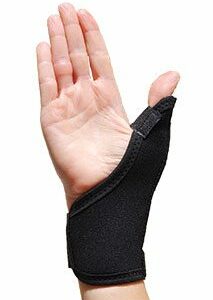Sprained Thumb
Updated:
(Also known as Thumb Sprain, ‘Skier’s Thumb’)
What is a sprained thumb?
A sprained thumb is a relatively common condition characterized by damage or tearing of the connective tissue (such as ligaments, cartilage and joint capsule) of the thumb.
The thumb comprises of 2 small bones known as phalanges. These small bones join to each other at the IP joint (Interphalangeal Joint) and to the bone at the thumb side of the palm (1st metacarpal) at the MCP joint (Metacarpophalangeal Joint) forming 2 joints for the thumb (figure 1). Each of these joints comprise of strong connective tissue wrapping around the bony ends and cartilage, which lies between the joint surfaces, cushioning the impact of one bone on another during activity.
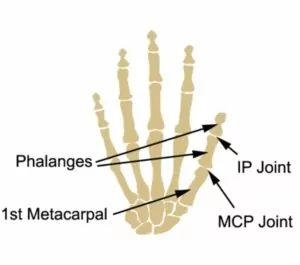
During certain movements of the thumb, stretching or compression forces are placed on the thumb joints. If these forces are excessive due to too much repetition or high force, injury to the joints may occur. This may involve damage to the cartilage or tearing to the connective tissue surrounding the joint (such as ligaments or joint capsule). When this occurs, the condition is known as a sprained thumb and may affect the IP or MCP joint.
Causes of a sprained thumb
Sprained thumbs are extremely common in ball sports, such as basketball or netball, and frequently occur due to a specific incident, such as a hyperextension force (backward bending of the thumb), hyperflexion force (excessive forward bending of the thumb) or a sideways force. A sprained thumb may also occur in contact sports due to a collision with another player or when tackling, or in martial arts (e.g. blocking a punch or kick with the thumb). A thumb sprain also commonly occurs in skiing when one of the hand poles forces the thumb backwards during an awkward landing or fall.
Occasionally, a sprained thumb may occur due to repetitive strain associated with overuse. This may be the case in patients who perform repetitive activities involving end of range movements of the thumb.
Signs and symptoms of a sprained thumb
Patients with a thumb sprain often experience a sudden onset of thumb pain during the causative activity. However, patients may also experience pain and stiffness after the provocative activity with rest (particularly at night or upon waking the following morning). Symptoms may be felt on the front, back or sides of the affected thumb joint and occasionally pain may be referred into the hand or wrist on the affected side. There may be an audible snap or pop sound at the time of injury. Swelling, bruising or colour change (such as redness) will often develop around the affected joint. Symptoms are generally exacerbated with activities that involve use of the hand, fingers and thumb such as catching balls, knocking the thumb, opening jars or doors, writing, picking up heavy objects, texting on a mobile phone, general gripping activity, cooking, household activities or placing weight through the affected hand and thumb.
It is also common for patients to experience pain on firmly touching the affected region, and, in some cases, a feeling of weakness in the hand and thumb may also be present. In severe cases, the thumb may be completely dislocated. All thumb dislocations need to be managed by a medical professional and should be X-rayed before and after being put back into place to confirm relocation and to exclude fracture.
Diagnosis of a sprained thumb
A thorough subjective and objective examination from a physiotherapist is usually sufficient to diagnose a sprained thumb and to determine the likely structures affected. Investigations such as an X-ray, MRI, CT scan or ultrasound may be required to confirm diagnosis and rule out other injuries (particularly fractures). Generally all traumatic thumb or finger injuries should be X-rayed.
Treatment for a sprained thumb

Members Only ContentBecome a PhysioAdvisor Member to gain full access to this exclusive content. For more details see Become a Member. Already a member? Login Now
Prognosis of a sprained thumb
In cases of a minor to moderate thumb sprain, return to sport or normal activity can usually occur in 2 – 6 weeks with appropriate management and treatment. Patients with a more severe injury will usually require a longer period of rehabilitation to gain optimum function.
Contributing factors to the development of a sprained thumb
Although a large number of thumb sprains are unavoidable, there are some factors which can increase a patients’ likelihood of experiencing a sprained thumb or suffering a recurrence. These factors need to be assessed and corrected with direction from a physiotherapist and may include:
- inadequate rehabilitation following a previous thumb sprain
- not using thumb braces or thumb taping during “at risk” activities, following a previous thumb sprain
- joint instability
- muscle weakness
- lack of co-ordination
- joint stiffness
- inadequate warm up
- inappropriate or excessive training or activity
- poor sporting technique
- decreased fitness or sport specific conditioning
- fatigue
Physiotherapy for a sprained thumb
Physiotherapy for a thumb sprain can hasten the healing process, ensure an optimal outcome and reduce the likelihood of recurrence. Treatment may comprise:
- thumb taping
- thumb bracing
- soft tissue massage
- electrotherapy (e.g. ultrasound)
- anti-inflammatory advice
- joint mobilization
- ice or heat treatment
- exercises to improve flexibility and strength
- education
- activity modification advice
- a gradual return to activity program
Other intervention for a sprained thumb
Despite appropriate physiotherapy management, a small percentage of patients with a thumb sprain do not improve adequately and may require other intervention. Some patients with severe injuries may also require other intervention to ensure an optimal outcome (such as immobilization, splinting or surgery). When this occurs the treating physiotherapist or doctor can advise on the best course of management. This may involve further investigation such as an X-ray, CT scan, MRI or ultrasound, pharmaceutical intervention, corticosteroid injection, or a review by a hand therapist or specialist who can advise on any procedures that may be appropriate to improve the condition. Occasionally, surgery may be required.
Exercises for a sprained thumb
The following exercises are commonly prescribed to patients with this condition. You should discuss the suitability of these exercises with your physiotherapist prior to beginning them. Generally, they should be performed 3 times daily and only provided they do not cause or increase symptoms.
Your physiotherapist can advise when it is appropriate to begin the initial exercises and eventually progress to the intermediate and advanced exercises. As a general rule, addition of exercises or progression to more advanced exercises should take place provided there is no increase in symptoms.
Initial Exercises
Thumb Opposition
Move your thumb to each finger tip beginning with your index finger and finishing with your little finger as demonstrated (figure 2). If your thumb can not reach your finger tips pain free, move as close as you can go without pain and provided you feel no more than a mild to moderate stretch. Repeat 5 – 10 times to each finger provided there is no increase in symptoms.
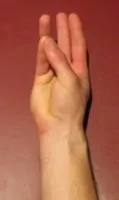
Thumb Extension to Flexion
Move your thumb away from your fingers and across your palm as far as you can go without pain and provided you feel no more than a mild to moderate stretch as demonstrated (figure 3). Repeat 10 times provided there is no increase in symptoms.
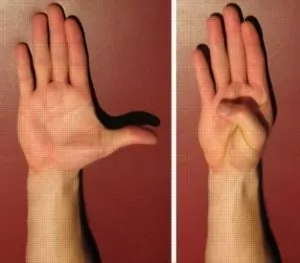
Intermediate Exercises

Members Only ContentBecome a PhysioAdvisor Member to gain full access to this exclusive content. For more details see Become a Member. Already a member? Login Now
Advanced Exercises

Members Only ContentBecome a PhysioAdvisor Member to gain full access to this exclusive content. For more details see Become a Member. Already a member? Login Now
Rehabilitation Protocol for a Sprained Thumb

Members Only ContentBecome a PhysioAdvisor Member to gain full access to this exclusive content. For more details see Become a Member. Already a member? Login Now
 Physiotherapy products for a sprained thumb
Physiotherapy products for a sprained thumb
Some of the most commonly recommended products by physiotherapists to hasten healing and speed recovery in patients with a thumb sprain include:
To purchase physiotherapy products for a thumb sprain click on one of the above links or visit the PhysioAdvisor Shop.
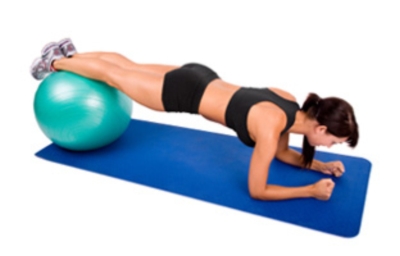 Relevant Physiotherapy Exercises
Relevant Physiotherapy Exercises
 Recommended Reading
Recommended Reading
- View detailed information on when to use Ice or Heat.
- Learn about initial injury management and the R.I.C.E. Regime.
- View detailed information on Thumb Taping.
- Read about Returning to Sport.
- View our Wrist & Hand Diagnosis Guide.
 Find a Physio for a sprained thumb
Find a Physio for a sprained thumb
Find a physiotherapist in your local area who can treat a thumb sprain.
Become a PhysioAdvisor Member
-
 Individual Membership (12 Months)$59.95 for 1 year
Individual Membership (12 Months)$59.95 for 1 year -
 Individual Membership (3 Months)$39.95 for 3 months
Individual Membership (3 Months)$39.95 for 3 months -
 Individual Membership (Yearly)$49.95 / year
Individual Membership (Yearly)$49.95 / year -
 Individual Membership (Monthly)$15.95 / month
Individual Membership (Monthly)$15.95 / month

Link to this Page
If you would like to link to this article on your website, simply copy the code below and add it to your page:
<a href="https://physioadvisor.com.au/injuries/wrist-hand/sprained-thumb”>Sprained Thumb – PhysioAdvisor.com</a><br/>PhysioAdvisor offers detailed physiotherapy information on a sprained thumb including: causes, symptoms, diagnosis, treatment, exercises, physiotherapy products and more...
Return to the top of Sprained Thumb.

